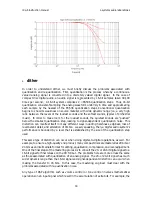
rdq-6 instruction manual
z-systems audio laboratories
22
appendix B: the relationship between Q and slope
The relationship between slope and Q is fairly straightforward but requires a bit of preliminary
explanation. Appendix A gives some background on the unique digital filter structure that
the rdq-6 uses for its parametric equalizer filters. This structure leads to the lowest-noise,
best–sounding digital filter possible. One of the few complications this structure imposes,
however, is a limitation on the range of possible bandwidths that can be realized.
With Q defined as
Q
f
BW
c
=
where BW is the 3-dB bandwidth in Hertz and f
c
the center frequency in Hertz, we start with a
nominal minimum Q
0
, equal to 0.4. The first slope value displayed by the rdq-6, “slope: 01,”
corresponds to a Q equal to Q
0
. Subsequent values of slope give multiples of Q
0
. Specifically,
we have
slope: 01 corresponds to Q
0
slope: 02 corresponds to 2Q
0
slope: 03 corresponds to 2.27Q
0
slope: 04 corresponds to 3.25Q
0
slope: 05 corresponds to 5Q
0
slope: 06 corresponds to 6.25Q
0
slope: 07 corresponds to 7.5Q
0
slope: 08 corresponds to 10Q
0
slope: 09 corresponds to 12.5Q
0
slope: 10 corresponds to 15Q
0
slope: 11 corresponds to 17.5Q
0
slope: 12 corresponds to 20Q
0
.
For the first 49 values of center frequency, Q
0
is equal to 0.4. For the last eight center
frequencies, Q
0
is different. This is because of the limitations placed on the range of possible
bandwidths for our special filter structure. For reference, we have
For f
c
< 8K00, Q
0
= 0.40
For f
c
= 8K00, Q
0
= 0.44
For f
c
= 9K00, Q
0
= 0.48
For f
c
= 10K0, Q
0
= 0.55
For f
c
= 11K2, Q
0
= 0.61
For f
c
= 12K5, Q
0
= 0.68
For f
c
= 14K1, Q
0
= 0.76
For f
c
= 16K0, Q
0
= 0.83
For f
c
= 18K0, Q
0
= 0.90.










































